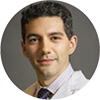You’ve been called in for an emergency facial trauma consult. Where do you start? What are the important things to examine and note? You can approach such patients in various ways, but here’s the approach I have found most helpful for examining a patient with a potential orbital fracture.
1. Clear the globe
Although I often review images and ask history first, the most important step we can take as ophthalmologists is to ensure that the patient has no globe rupture. Scleral lacerations, choroidal ruptures and the like preclude fracture repair. Globe manipulation during repair in such cases can cause further vision loss and eye injury.
2. Take a great history
Before you touch a patient, make sure you hear the story from him/her or someone who was present when the trauma occurred. What is the possibility of foreign bodies being present? Small amounts of organic tissue can introduce virulent gram-negative infections. A good history also empowers you to judge symptoms after injury. Does the patient have a history of amblyopia or other ocular history? Include meds, diagnoses and past surgeries.
3. Review all imaging windows and sequences
Commonly, the emergency provider performs CT scans prior to your arrival.
Make sure the scan is an orbital one (with narrower cuts).
Review the bone window for any fractures and the soft-tissue window for extraocular muscle position, hemorrhages and foreign bodies, among other potential findings.
Remember that entrapment is a clinical diagnosis and that organic foreign bodies may not be obvious on exam.
Mouse over areas that appear to have a density similar to air and check on the Houndsfield units. You can discern organic tissue from air in this manner as most cuts will have sinus air as a comparative baseline.
4. Complete a subjective exam
If the patient is not altered or sedated, gather as much of your subjective exam as possible. With a head trauma patient, you don’t know when you will have your next opportunity to gather such information.
For the neuro-orbital exam, remember to test extraocular movement in each eye separately, as well as confrontational visual fields.
Include a swinging-flashlight test to rule out afferent pupillary defects, color plates and red desaturation, which allows for comparison of cranial nerve II function between eyes.
5. Touch the patient!
Feel the orbital rim, test retropulsion on both sides and potentially check forced ductions (check with your attending’s preferences for cooperative fracture patients with incomplete EOMs).
Put your hands on their temporomandibular joint and have the patient open and close their mouth. Do they have trismus? Crepitus? Always check for asymmetry or loss of sensation in the V1 and V2 distributions, which extend to the teeth.
Don’t let the face be your black box. Be confident in examining the globe as well as its surrounding anatomy.
6. Make a decision
Is there an indication for orbitotomy or fracture repair? Some examples could be: 1) if the orbit is tense/under pressure, 2) enophthalmia, 3) muscle entrapment or other restrictive diplopia not likely caused by soft-tissue swelling and 4) large (>50%) floor fractures.
If the answer is yes, discuss the benefits and risks of surgery with patients and family, as appropriate.
If there is no immediate need for repair, you must schedule outpatient follow-up or check on the patient if admitted. Globe dystopia can present once edema has subsided. In rare cases, injury can lead to long-term fat atrophy, creating the need for delayed repair.
You did it! You have carefully approached the orbital trauma patient and discerned their need for care. Trauma patients are under great duress in the emergency care setting. Your preparedness and calm approach will help both you and their recovery.
* * *
 About the author: James G. Chelnis, MD, is assistant professor in oculoplastics at the New York Eye and Ear Infirmary of Mount Sinai. He has been on YO Info’s editorial board since 2012 and was appointed chair in 2017.
About the author: James G. Chelnis, MD, is assistant professor in oculoplastics at the New York Eye and Ear Infirmary of Mount Sinai. He has been on YO Info’s editorial board since 2012 and was appointed chair in 2017.